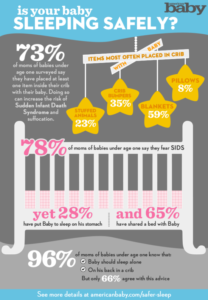Sudden infant death syndrome (SIDS)
This condition is the unexplained death, usually during sleep, of a seemingly healthy baby less than a year old. SIDS is sometimes known as crib death because the infants often die in their cribs.
Although the cause is unknown, it appears that SIDS might be associated with defects in the portion of an infant’s brain that controls breathing and arousal from sleep.
Researchers have discovered some factors that might put babies at extra risk. They’ve also identified measures you can take to help protect your child from SIDS. Perhaps the most important is placing your baby on his or her back to sleep.
Causes
A combination of physical and sleep environmental factors can make an infant more vulnerable to SIDS. These factors vary from child to child.
Physical factors
Physical factors associated with SIDS include:
- Brain defects. Some infants are born with problems that make them more likely to die of SIDS. In many of these babies, the portion of the brain that controls breathing and arousal from sleep hasn’t matured enough to work properly.
- Low birth weight. Premature birth or being part of a multiple birth increases the likelihood that a baby’s brain hasn’t matured completely, so he or she has less control over such automatic processes as breathing and heart rate.
- Respiratory infection. Many infants who died of SIDS had recently had a cold, which might contribute to breathing problems.
Sleep environmental factors
The items in a baby’s crib and his or her sleeping position can combine with a baby’s physical problems to increase the risk of SIDS. Examples include:
- Sleeping on the stomach or side. Babies placed in these positions to sleep might have more difficulty breathing than those placed on their backs.
- Sleeping on a soft surface. Lying face down on a fluffy comforter, a soft mattress or a waterbed can block an infant’s airway.
- Sharing a bed. While the risk of SIDS is lowered if an infant sleeps in the same room as his or her parents, the risk increases if the baby sleeps in the same bed with parents, siblings or pets.
- Overheating. Being too warm while sleeping can increase a baby’s risk of SIDS.
Risk factors
Although sudden infant death syndrome can strike any infant, researchers have identified several factors that might increase a baby’s risk. They include:
- Sex. Boys are slightly more likely to die of SIDS.
- Age. Infants are most vulnerable between the second and fourth months of life.
- Race. For reasons that aren’t well-understood, nonwhite infants are more likely to develop SIDS.
- Family history. Babies who’ve had siblings or cousins die of SIDS are at higher risk of SIDS.
- Secondhand smoke. Babies who live with smokers have a higher risk of SIDS.
- Being premature. Both being born early and having a low birth weight increase your baby’s chances of SIDS.
Maternal risk factors
During pregnancy, the mother also affects her baby’s risk of SIDS, especially if she:
- Is younger than 20
- Smokes cigarettes
- Uses drugs or alcohol
- Has inadequate prenatal care

